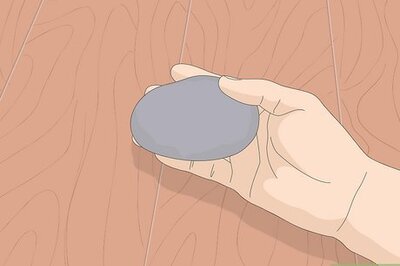
views
Pre-budget speculation in the media accorded low priority to health in the expected budget proposals. Even public health advocates were doubtful if the union budget of 2018 would fix its vision on delivering universal health coverage (UHC) by 2030, as the country committed when it adopted the SDGs.
With several state elections dotting the road to the national elections scheduled for 2019, the attention was expected to be on spurring economic growth and placating multiple aggrieved constituencies. However, the headline grabbing announcement of the budget was the plan to implement the ‘world’s largest health insurance scheme’!
While announcing a firm commitment to the vision of UHC, the Finance Minister appears to have kept sight of the NITI Aayog’s goal of reducing out-of-pocket expenditure on health to 50% by 2020, from the 63% it had estimated in its Action Plan of 2017. The National Health Protection Scheme (NHPS) is not new. It was announced in the budget of 2016, as the revamped version of Rashtriya Swasthya Bima Yojna (RSBY) as that scheme migrated from the Labour Ministry to the Health Ministry.
NHPS stayed quiet in the budget speech of 2017, as intra-governmental debates on the scheme’s form and delivery channels continued. What captured attention this year is the sharp rise in financial coverage to INR 5 lakhs per family per annum, from the current cap of INR 30,000 and extension to 10 crore poor and vulnerable families (potentially 50 crore beneficiaries).
NHPS was coupled with a proposal to deliver comprehensive primary health care, under the evocative label of Ayushman Bharat, to prepare the road for UHC. The National Health Policy(NHP) had affirmed that primary health care would receive the highest priority and 70% of the public financing for health.
The budget allocates 1200 crores INR to fund the transformation of 1,50,000 sub-centres in to Health and Wellness Centres which will provide comprehensive primary care services ranging from health promotion and disease prevention to provision of basic clinical services along with free drugs and diagnostics. Building on the current platform of the National Health Mission(NHM), primary health services will now extend care for non-communicable diseases and mental illness.
Are the resources allocated adequate to match the ambition of these initiatives? Will implementation be as sharp as the vision? The rise in the budget of NHM is insufficient to galvanise primary health care. The urban health mission lies in a dark recess of NHM without the power to generate speed and scale. The biggest challenge will be the limited health workforce available to deliver the promised primary services with the required outreach, effectiveness, impact and equity.
Unless the NHM is adequately financed to invest in quickly scaling up the numbers and skills of technology enabled community health workers, mid-level health care providers and allied health professionals, comprehensive primary health care will remain aspirational.
Even NHPS will not deliver optimally, without strengthening the capacity of governmental or empowered autonomous agencies to engage in strategic purchasing of secondary and tertiary care from public and private providers. Without that capacity, the ‘fee for service’ model of payment recommended by the NHP will quickly drain the funds of NHPS through induced care (unnecessary procedures and hospital admissions) which will compete with need based appropriate care.
A well defined package of services to be covered under NHPS, standardised diagnostic approaches and treatment guidelines, and monitoring systems for adherence to set cost and quality standards, would be needed to enable efficient operation of the scheme.
The 2000 crore INR allocation to NHPS does not match the scheme’s profile. Additional resources would have to be garnered, by merging the several independently operating health insurance schemes funded by state governments.

That would also create a ‘single payer’ system which can use the power of monopsony to procure services at the best negotiated price and demand quality. This has worked for pooled public procurement of drugs and will work for clinical services too. The amount of premium demanded under NHPS is unknown as yet. Will it stay at the present level or will the higher cost coverage also raise the premium level? If NHPS succeeds in performing to expectations, even the non-poor can subscribe to the scheme paying higher premiums, thereby increasing the risk pool and opening the road to UHC.
For UHC to be achieved, however, tax based public financing of health has to go up and coverage of outpatient and in-payment services will have to be combined in a ‘bundled care provision’ model through networks of health care providers. Those innovations await future budgets.
Strengthening of 24 district hospitals to host 24 new medical colleges is a much needed move that will not only strengthen public sector capacity to deliver advanced care at district level but also position medical colleges in district clusters that don't have any. Scaling up the production of basic and specialist doctors is a high priority that this initiative will partly meet.
Initiatives to address health beyond health care, through actions that address the social and environmental determinants of health, are very welcome. Air pollution has been ranked recently as the second largest contributor to India’s ill health.
Financial support to Delhi’s neighbouring states to invest in technologies for in-situ disposal of agricultural waste, through non- burning methods, will help relieve some of the agony of the capital’s ambient air pollution.
Expansion of the Ujjwala scheme to provide 8 crore more cooking gas connections to poor women will free them from the kitchen’s curse of indoor air pollution created by solid fuel combustion. Expansion of the Swachh Bharat Abhiyan to build 2 crore more toilets will help to reduce the risks of open defecation.
Even as programmes to improve the nutrition of children, girls and women are scaled up, it is heartening to note the financial support provided to patients of tuberculosis to access better nutrition. This will help them to improve their immunity and achieve better treatment outcomes.
(K Srinath Reddy is President, Public Health Foundation of India. Views expressed are personal)
















Comments
0 comment